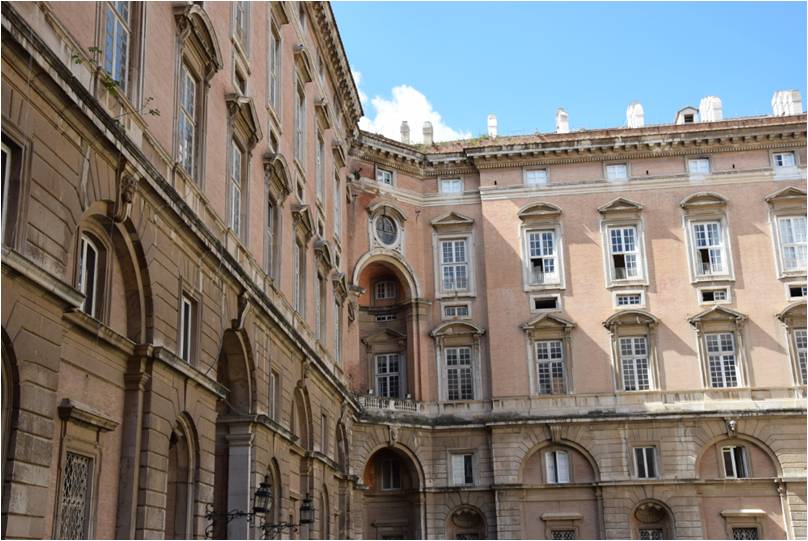
Find in this gossip guide for the 18th century:
- Palace, Pomp and Politics
- The British Ambassador as Tomb Raider
- Love & the Palace
- Shocking: Emma and Nelson!
- A King from France & the English Princess

Find in this gossip guide for the 18th century:
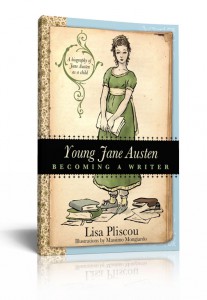 I am delighted to have Lisa Pliscou, acclaimed author of both fiction and nonfiction, as guest writer at Regency Explorer. In her newest book, Young Jane Austen: Becoming a Writer, Lisa highlights Jane Austen’s creative development as a child and teenager. It’s a treat for me to present Lisa’s insightful post about a rather unknown aspect of Jane Austen’s life:
I am delighted to have Lisa Pliscou, acclaimed author of both fiction and nonfiction, as guest writer at Regency Explorer. In her newest book, Young Jane Austen: Becoming a Writer, Lisa highlights Jane Austen’s creative development as a child and teenager. It’s a treat for me to present Lisa’s insightful post about a rather unknown aspect of Jane Austen’s life:
As I was making my way through a stack of Jane Austen biographies — what began as pure enjoyment and ultimately became research for my Young Jane Austen: Becoming a Writer — I was surprised to see that occasionally, an author would tally Jane’s siblings and end up with six.
The correct number, of course, is seven; altogether there were eight Austen children, beginning with James and ending with Charles. Jane’s older brother George, somehow, slipped between the cracks.
And why? Because he was the “defective” Austen child. Continue reading
In this post:
 Reverend John Skinner shuddered as he looked at the narrow path ahead. The passage, just four feet or a meagre 1.2 m wide, was cut on the side of a cliff that descended steeply towards the sea. He dismounted his horse and continued his dangerous journey on foot, leading the animal behind him.
Reverend John Skinner shuddered as he looked at the narrow path ahead. The passage, just four feet or a meagre 1.2 m wide, was cut on the side of a cliff that descended steeply towards the sea. He dismounted his horse and continued his dangerous journey on foot, leading the animal behind him.
The Reverend enjoyed discovering the wilderness of Exmoor. In 1801 he reached Lynton and Lynmouth, two tiny villages on the North Devon coast. ‘To travelers not accustomed to a mountainous country, the approach to this place would have deemed impassable’, he noted in his journal. John Skinner was among the first who made their way to Lynton and Lynmouth to admire the view and dramatic scenery. More were to follow. And this was all because of the French.
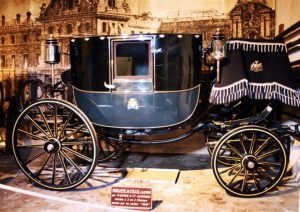 In the age of the carriage, several hundred models of horse-drawn vehicles existed. Don’t worry, you do not have to look at all of them. For this exhibition, I took photos at Historic Houses and Museums in France and England, and I have selected the carriages most commonly used in the Romantic Age. Some of them are indispensible for a Regency Novel and some are beautifully quirky. All in all, here are 20 carriages for you to enjoy. Continue reading
In the age of the carriage, several hundred models of horse-drawn vehicles existed. Don’t worry, you do not have to look at all of them. For this exhibition, I took photos at Historic Houses and Museums in France and England, and I have selected the carriages most commonly used in the Romantic Age. Some of them are indispensible for a Regency Novel and some are beautifully quirky. All in all, here are 20 carriages for you to enjoy. Continue reading
In this post:
Inventions and science in the Romantic Age
Help, my father is an inventor!
Martha Pocock as a character of a novel – and plot bunnies involving the Pocock family
Martha Pocock was not what we associate with a typical girl of the Romantic Age. She was neither an epitome of propriety nor a simpering Miss. Martha had guts and she was hands-on. She was the first woman to be lifted into the air under a kite. Martha owed her experiences in flying under a kite to her father. George Pocock (1774–1843) was an inventor and a schoolmaster. He became famous for inventing the first kite-drawn carriage. Sounds like a joke? It’s not.
A fan was a popular accessory in the Romantic Age. No lady would be seen without a fan at a ball or assembly. The design of the fans was as varied as was the fashion. Often political events were celebrated or commemorated with special designs for fans. The victories of the British Army during the Peninsular Wars and the Battle of Waterloo were such occasions. It is even possible to tell a brief history of the Napoleonic Wars in 10 beautiful fans made between 1800 – 1816.
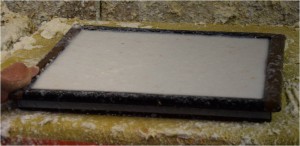 In the Romantic Age as well as today, high-quality watercolour-paper for artists is the so called wove paper ready-sized with gelatine. This paper is still produced at Two Rivers Paper Mill in Somerset, England. I went there to learn more about this traditional craft. You can read about my field trip to their workshop here.
In the Romantic Age as well as today, high-quality watercolour-paper for artists is the so called wove paper ready-sized with gelatine. This paper is still produced at Two Rivers Paper Mill in Somerset, England. I went there to learn more about this traditional craft. You can read about my field trip to their workshop here.
In this post:
The traditional making of watercolour-paper
Watercolour-painting’s Golden Age
Technical innovations at the service of art
How to use making watercolour-paper or watercolouring in your Regency Novel
 The pleasant village of Roadwater lies a couple of miles behind us, and the small road leads into a forest. We are on a field research trip to Two Rivers Paper Mill in Somerset/UK to learn about the traditional production of watercolour paper. Exploring the Regency period can be exciting – and might include loosing the way. We are about to turn the car, when we see a white building with a black slate roof. It is Two Rivers Paper Mill, built in the 1680ies. In the Georgian era, the mill was a thriving corn mill, known as Pitt Mill. Today, the mill is a centre of the traditional production of a paper that was vital for the latest trend in arts during the Romantic Age: high-quality watercolour-paper.
The pleasant village of Roadwater lies a couple of miles behind us, and the small road leads into a forest. We are on a field research trip to Two Rivers Paper Mill in Somerset/UK to learn about the traditional production of watercolour paper. Exploring the Regency period can be exciting – and might include loosing the way. We are about to turn the car, when we see a white building with a black slate roof. It is Two Rivers Paper Mill, built in the 1680ies. In the Georgian era, the mill was a thriving corn mill, known as Pitt Mill. Today, the mill is a centre of the traditional production of a paper that was vital for the latest trend in arts during the Romantic Age: high-quality watercolour-paper.
Continue reading
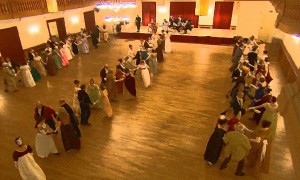 Music fills the ball room. The English chamber orchestra The Pemberley Players strikes up. About 100 persons dressed in historical costumes dance the elegant formations of the opening polonaise, smiling and greeting each other. A glittering ball set in the Regency period begins: We are at the Grand Jane Austen Ball, pretending to have travelled in time back to Regency England.
Music fills the ball room. The English chamber orchestra The Pemberley Players strikes up. About 100 persons dressed in historical costumes dance the elegant formations of the opening polonaise, smiling and greeting each other. A glittering ball set in the Regency period begins: We are at the Grand Jane Austen Ball, pretending to have travelled in time back to Regency England.
Here is my new 5-Minute Novel. Inspiration hit me when I was doing research for my post “Writer’s Travel Guide: The Jersey Connection“. I found a most useful book about the Isle of Jersey during the Romantic Age: Balleine’s History of Jersey. While I read the passages about the French émigrés at Jersey, plot bunnies sprang up. Read here the story they carried with them.
Wiltshire, 1793: The orphaned siblings Eliza (24) and William Redruth (20) live with their elderly aunt Margret in shabby-genteel circumstances in the countryside. One day in May, they receive a letter: A distant uncle, Baronet John Redruth, died in old age on the Isle of Jersey. Being without children, John Redruth has decided to make William the heir of his manor house on the isle. These are exciting news. Williams wants to travel to the Isle of Jersey immediately to inspect the inheritance. The ladies warn him: Due to the war with France, the island located so close to France is in danger of being invaded. Continue reading